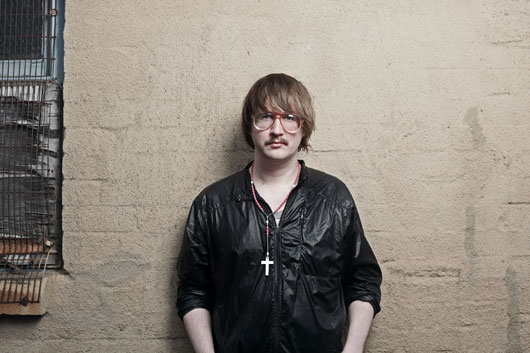Inside ‘Room(s)’: Machinedrum’s Travis Stewart discusses the new sound of his latest LP.
Brooklyn-based producer Travis Stewart has never been content to sit still artistically. In the decade-plus […]

Inside ‘Room(s)’: Machinedrum’s Travis Stewart discusses the new sound of his latest LP.
Brooklyn-based producer Travis Stewart has never been content to sit still artistically. In the decade-plus […]

Brooklyn-based producer Travis Stewart has never been content to sit still artistically. In the decade-plus time he’s spent carving his own niche out of the amorphous realm of electronic dance music, the prolific artist has jumped from label to label to label, dropping loads of releases that all flirt with an array of disparate genres and yet sound inextricably linked in production style and quality. Whether making music as Neon Black, Machinedrum, or with Praveen Sharma as part of the Hotflush-signed Sepalcure, Stewart is constantly evolving, expanding his sonic palette to include elements of house, techno, juke, electro, ambient, hip-hop, IDM, and beyond. Now, years after he released the last proper Machinedrum LP, the glitchy Want to 1 2?, Stewart returns with a brand-new solo album for Planet Mu called Room(s), and it’s no surprise that it sounds unlike anything he’s done before.
“I think, as far as Want to 1 2? is concerned, it had more of a focus on bridging the gap between experimental electronic music and pop, so it ended up having a certain kind of sound,” says Stewart over Skype from Berlin, where he’s staying for the summer. “And a lot of pop music in general is a bit more in-your-face than other music, because that’s the style of it, especially with modern pop music. As far as [Room(s)] is concerned, I feel like it can definitely get in your face again, but in a different way. It’s kind of smoothed out a bit more with the atmospheric stuff I’ve been getting into and the melodic aspects that pull it back from being overwhelmingly drum-heavy.”
“Let It (feat. Melo-X)” from Want to 1 2?

Calling his record “drum-heavy” is somewhat of an understatement. Room(s) is first and foremost about rhythm. It’s a dance record through and through, but there’s an inherent introspection and tenderness in the songs that was rarely present in Stewart’s previous solo material. Tracks like “She Died There” and “U Don’t Survive” put skittering 808 beats, chopped percussive sounds, and cyclical, footwork-referencing vocal hooks at the core of their hot-footed grooves, but Stewart softens the edges with delicate synth tones and a lingering layer of gauzy atmosphere, which adds to the versatility of the songs being appropriate to hear at home, on a club’s soundsystem, or in headphones. You can’t help but think of Sepalcure in the midst of listening to it.
“[Sepalcure] is definitely an influence in what I do, but I could pretty much say that with any record I’ve ever done,” he admits. “Whatever I’m surrounding myself with at that time is going to inevitably influence the sound I’m creating. The stuff that I’ve done with Praveen has definitely been a big influence on [Machinedrum’s] current sound.”

But past production work and side-projects aren’t the only elements at work within the 11 touching cuts that make up Room(s). The record is very much about being in the moment. It’s the sound of Stewart recording ideas as they hit. He explains: “A big part of capturing that inspiration is trying to get a song as complete as I can during that first session, so that it becomes extremely difficult to accidentally take it in any other direction when I revisit it again in the studio.”
That immediacy would come to dictate, in a big way, how the new album was written. “[The method] was more or less something that I discovered on my own just from working on the road a lot,” says Stewart. “Having limited time to sort of jot down ideas, I want to be able to get as many out in a short period of time as I could. Otherwise, what was happening to me was I would start working on a track, and would spend too much time working on one element and would not actually have an opportunity to revisit that same song until maybe even a month later. So, the track essentially becomes something completely different. I wanted to avoid that as much as possible.”
“Sacred Frequency” from Room(s)

That “of the moment” energy drives Room(s), and sets it apart from the rest of Machinedrum’s discography. Songs like the deep, emotive “Lay Me Down” and pensive album closer “Where Did We Go Wrong?” sound like Stewart contemplating his wants and desires directly through music, while less somber productions—like “Sacred Frequency” and “Come1″—are pure party tunes that owe as much to dancefloor classics as they do navel gazing. It all makes for an even-handed and enticing record across the board, but as Stewart tells it, Room(s) is basically a personal scrapbook of his own handmade sounds, which could in turn make it that much more of a rewarding listen.
“I felt like the songs sonically, stylistically, and aesthetically fit [together],” he says. “They all seemed like they were brothers and sisters of each other, and I felt like each song together made a whole piece, like a house in a way… It’s a collection [of music] from a period of time in my life.”
Room(s) is out on July 25 via Planet Mu.

